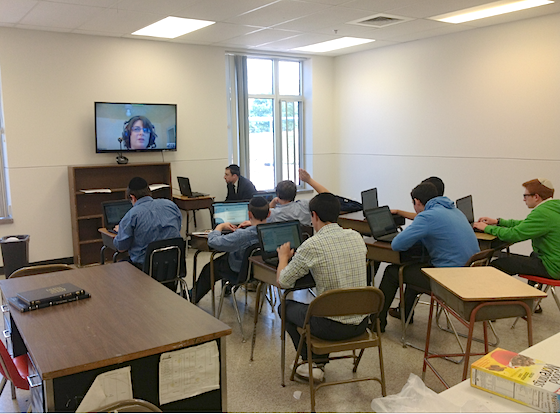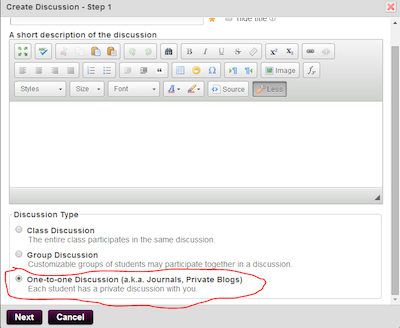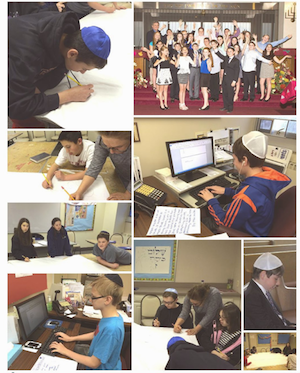Editor’s note: In Smadar Goldstein’s first post about student collaboration online, she touched on issues of students sharing work products as well as the tools and methods she uses to encourage virtual engagement. In this second segment, the global online educator highlights her methods for follow-up with individual students and goes deeper into the ethics issues, including cheating.

by Smadar Goldstein
When giving workshops about online collaborative learning, I’m frequently asked: Why is this better than the way students traditionally learn?”
As I’ve said, I enjoy when my students learn from each other. Online discussion forums and bulletin boards provide a means to share our ideas in a format that is not constrained by time, that saves all our thoughts, and that allows students to return to their contributions and even change them once they’ve read others’ posts.
None of this can be accomplished if students submit their papers individually to a teacher. Even if I began passing their papers around for them to peruse each other’s work, it would require a great deal of time and extra coordination.
Now that I’ve set up my classroom collaboratively, I cannot imagine returning to a non-collaborative environment. I find that everyone learns so much more this way. And isn’t that a goal of education? And whether you’re teaching from thousands of miles away or sharing a physical space with your students, an online component can provide unique shared learning opportunities.

Student follow-up
How do I follow up if I’m an online teacher? In some situations, I am teaching two Judaic education classes in the same school at the same time – one class for girls and the other for boys. If I speak to a student, everyone hears; even the opposite gender students in an entirely different classroom.
Face to face teachers have the luxury of calling over a student to speak to him/her privately or going into the hall. In my distance learning context, I can do any of the following:
– use gchat
– comment on student’s private Google Doc or PPT
– respond to student in a discussion forum using private mode
– message the student on Haiku (this is private)
– use email
– speak about it “face to face” in our live platform, once they’ve given me the all clear that they don’t mind discussing this while others can hear.
There are lots more ways to interact with students nowadays. Some of them prefer writing to me, even if they are able to speak to me privately. This is a generation of texters, emailers and Facebook posters. Why wouldn’t they feel more comfortable writing their responses? Writing is acceptable for some follow up. But I definitely have oral follow up with my students regularly as well.
What if they plagiarize?
In my first post, I considered where the line might be drawn between collaborating on work and using another student’s work inappropriately. Here’s another scenario: suppose a student copies another student’s response word for word?
This happened once on an assignment on Jewish identity. I posted a video introducing Jewish identity by former British Chief Rabbi Jonathan Sacks, then asked students to post three items and photos in a collaborative Google Presentation stating what enhanced their Jewish Identity. One boy – let’s call him “Jack” – was a capable student but sometimes a lazy one. He simply copied and pasted the responses from “Jill,” another student in the class.
I said ”Jack, I noticed your response shared the same verbiage as Jill, and I know that Jill posted her response first. Why do you think that is?'”
An ensuing discussion revealed that Jack, an extremely intelligent student, had so wholeheartedly agreed with what Jill wrote that he felt no need to create his own post. He said he felt comfortable “sharing” hers, since he felt she expressed exactly what he wanted to say.
 The words “copy” and “share” are sometimes vague for students. I realized that I needed to address this difference. I let Jack know that while I was thrilled he agreed with Jill’s response, he needed to originate his own content. I also gave him an extra credit assignment to complete. I was clear that I was disappointed that he had “shared” Jill’s response without reference or attribution, and at his age (15) I expected him to understand the difference.
The words “copy” and “share” are sometimes vague for students. I realized that I needed to address this difference. I let Jack know that while I was thrilled he agreed with Jill’s response, he needed to originate his own content. I also gave him an extra credit assignment to complete. I was clear that I was disappointed that he had “shared” Jill’s response without reference or attribution, and at his age (15) I expected him to understand the difference.
Jack ended up posting his own response to the original assignment, which was fabulous, and creating an interesting and creative extra credit Animoto project. Jack combined all the responses from the Google slideshow we used to present the students’ Jewish Identity presentations, with additional photos of his own, into an Animoto video.
The class watched it together, which generated a lot of laughs, joy of learning, and additional discussion. So the ‘file sharing’ experience ended up being a learning experience for everyone.
More student comments about online learning
Here is some additional student feedback. Note the benefits that are unique to collaborative and/or online learning styles:
 â–º I have learned how to be a responder – how to learn about a controversial topic and respond in a polite way that expresses my opinion. I like how this class is about my personal connection to Jewish history; we aren’t memorizing the facts, and I feel that I remember more through this method. When a student makes a stronger connection to the material, we are more likely to remember it!
â–º I have learned how to be a responder – how to learn about a controversial topic and respond in a polite way that expresses my opinion. I like how this class is about my personal connection to Jewish history; we aren’t memorizing the facts, and I feel that I remember more through this method. When a student makes a stronger connection to the material, we are more likely to remember it!
â–º I have become more familiar with technology and more comfortable being adventurous with learning. Seeing that there are so many different ways to structure a class has made me more excited about learning. I tend to be a visual learner and so having different mediums for learning (audio, visual, etc…) insures that there’s something for everyone. I like the variety!
â–º Of the many online tools I enjoy, my favorite is powerpoints because there is so much creative opportunity. You are only limited to what your imagination can bring from the technology. There are so many ways to express yourself and different ways of seeing the information. And since everyone learns differently, this is an incredible gift!
â–º I really enjoy lino boards. It’s cool to be able to post your ideas (with pictures and videos) and to be able to comment on each other’s posts. I often learn just as much from my fellow students as I do from my teachers. It’s great to gain knowledge by sharing from each other.
This last post reminded me of a famous quote from the Talmud. The Talmudic sage Rabbi Hanina, who lived in Israel under Roman rule in the 3rd Century, stated:
“I have learned much from my Rabbis, but from my friends I have learned even more. And from my students, I have learned the most of all.” (Talmud Ta’anit, Page 7A )
In conclusion . . .
The technologies of online learning serve many purposes for me. My main loves are the organization of the material, the easy access to web-based tools, and the ability to building bridges for collaborative learning.
I provide guidelines for my students on using the tools. Even tech savvy high schoolers appreciate user friendly techniques. Collaborative learning requires adjustment time, lots of positive feedback and room for reflection.
In the matter of cheating vs. collaborating, guidelines and expectations need to be set. But teachers can also gain from looking at learning from a different perspective. Learning will increase with constant follow up and reflection.
My students and I strongly vote for collaborative learning as the preferred way to increase our knowledge and skills. We love sharing ideas as a group; we love having a structure that allows us to post our thoughts at times that suit us best. We love using a platform that saves our work, and that also allows time for reflection, reactions and evaluations.
I’d love to be in touch with other teachers who support collaborative learning and learn from you and your students how to increase the benefits of using this method of learning in the classroom. Please drop me a note at Smadar@jetsisrael.com.
Smadar Goldstein
Latest posts by Smadar Goldstein (see all)
- Why I Would Never Go Back to Offline Teaching - June 19, 2014
- Cheating vs Collaborating in Online Learning Environments - May 30, 2014
- What is Your Ideal School? - October 31, 2013


Thank you for your post. I cannot imagine going track to ‘traditional’ ways of assessing, recording, organizing, and also cannot imagine not providing students with web- based tools and providing those for collaboration. I am especially looking forward to ePortfolios this year and the potential of LMS’s and GAFE with my students;)
Hi Deborah,
Thanks for your feedback. I spoke to a teacher today at workshop where I was mentoring and discussed the advantages of PBL and using online tools over traditional tests. She said ‘some students like taking tests. I wouldn’t want to give them up.’
I think there is a long way to go to see a majority shift in using EdTech tools, unfortunately. I also like using ePortfolios and cannot imagine teaching without an LMS!
Let’s hope that we can continue to spread the benefits and that other teachers jump on board this fantastic journey.